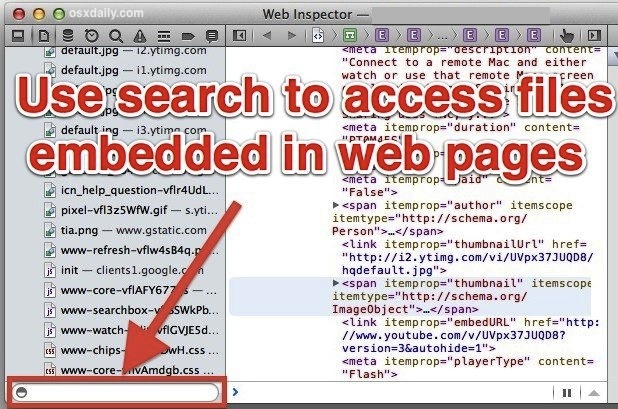Find & Access Embedded Files in Safari on Mac with Page Resources
![]()
Need to locate some embedded page resources in Safari on MacOS? You can do that with Page Resources feature, a handy capability for any web developer, web designer, or web worker.
While past versions of Safari included a feature called Activity Monitor that let you easily see and access resources loaded on a web page and even download embedded files like javascript, images, css, FLV video, mov files, and audio, that capability is no longer available. The Activity Monitor feature was widely used by web developers, but it has been removed from Safari 6 onward, meaning if you want to track down files embedded into web pages and see other resources, you’ll have to use the Page Resources feature found within the developer menu instead.
This guide will demonstrate how to use the Page Resources feature to find embedded media and other source files on a web page.
How to Find Embedded Files, Media, & Resources in Safari on Mac
- First, enable the Safari Developer menu if you haven’t done so already by opening Safari Preferences, going to the “Advanced” tab, and checking “Show Develop menu in menu bar”
- Navigate to the web page where you’d like to access page resources
- Pull down the Develop menu and select “Show Page Resources”
- Use the search box to find the embedded files or resources you are looking for, for best results search for file extensions

You’ll be able to easily find embedded files, media, and other data through this tool, which is likely already familiar to web developers.
Common file types like images, scripts, and stylesheets, are broken into subfolders in the page resources menu, which makes browsing through all of them simple enough, though the search feature is much faster if you know exactly what you’re looking for.
A few things to keep in mind here; in order to find FLV files accessible in the Resources search you must have the Flash plugin installed in Safari, because it won’t load the embedded flash file otherwise – though you will be able to find a link to it if you wish to access a FLV or SWF file for whatever purpose.
Similarly, many audio files are accessible behind AJAX players and can make it difficult to find the actual audio file, or Flash players and also will require the Flash plugin to be installed before they load.
You’ll also find that not all embedded files are shown with a file extension and they may not be returned in the generic search, if that’s the case you can typically locate them within the “Other” folder in page resources instead.
Another way to download embedded files is to copy the URL from the Page Resources after you find what you’re looking for, and then use curl -o to download it by pointing at the file URL path on the remote server, a handy trick that is able to retrieve just about any type of media document, file, or data. We discussed a similar trick quite some time ago with downloading flash videos from the web with curl and it works for audio, video, PDF, and many other embedded file formats, as well as images, text, and just about any other files from the web through the powerful command line tool.


Know this is old, but …
1. Do the above, find the resource (if you don’t see it reload the page with the resources displayed because sometimes the items under Other don’t show up there unless the resources list is already displayed)
2. Double click on the resource, it will open in a new tab
3. Click the url at the top of the screen and click option-return to save it.
4. If that doesn’t work, right-click on the resource and click “copy link”
5. open Terminal and type cd ~/Downloads
6. type “curl [[link copied above]] -o [[type a filename for the file]. So like “curl http://foo.com/bar.mp4 -o saved.mp4″
— type man curl for many command line options
7. imo 4-6 shows why mac is better. Unix>>DOS.
am i being stupid? it doesn’t tell you how to download the files, just tells you to use developer menu to find. and then what?!